While the return of the Champions League is, for very obvious reasons, the top story of the week, the European soccer weekend will provide quite a bit of intrigue — and existential dread — as well. Three big rivalry matches — AC Milan vs. Inter Milan, Liverpool vs. Everton, Schalke vs. Borussia Dortmund — come packed with both importance and big story lines.
Let’s preview them!
Milan derby: Inter Milan at AC Milan
Sunday, 9:00 a.m. ET (ESPN+)
Watch AC Milan vs. Inter Milan, ESPN+ (U.S. only)
Last 10 derbies: six wins for Inter, two four Milan, two draws
What’s at stake: It’s “Mission: Scudetto” in Milan these days. Juventus has won the last nine Serie A titles, but Milan (last title: 2011) and Inter (2010) lead the way over halfway through. A winner on Sunday might both earn bragging rights and secure “favorite” status.
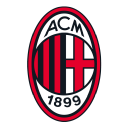
AC Milan’s defense is creaking
Both Inter and AC Milan are on pace for 84-86 points in league play, with Juventus on pace for 76. Inter has the best scoring average of the three (2.5 goals per match), and Juve has the best defense (0.9 goals allowed); Milan are second in both categories. If we break attack and defense out into shot quantity and shot quality, though, Milan’s defense is probably the most worrisome of the trio.
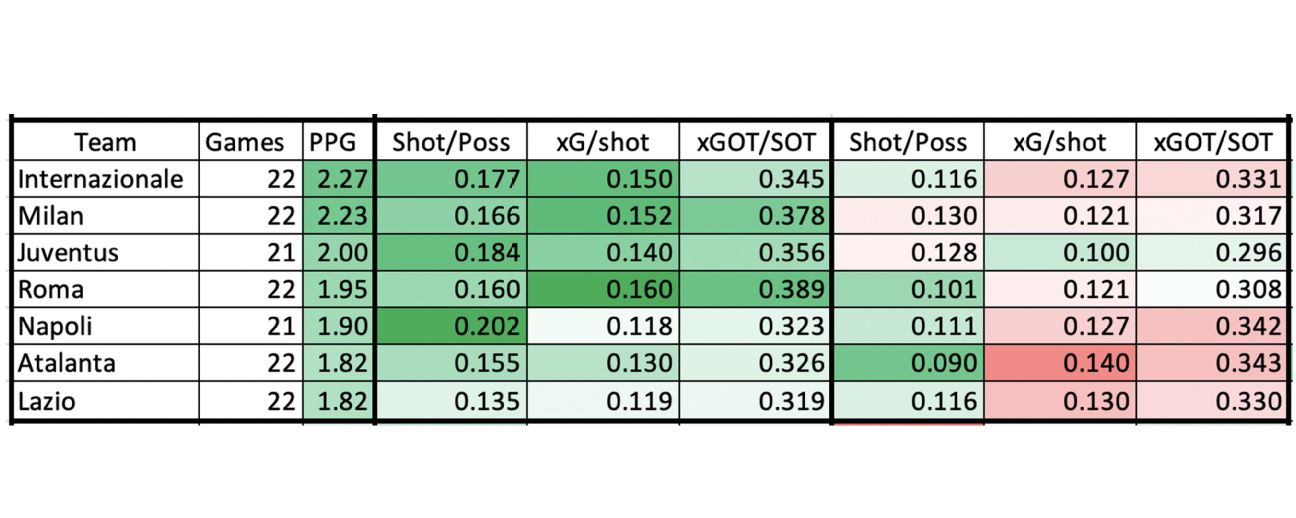
(A key: Shot/Poss = shots per possession, xG/shot = expected goals per shot, and xGOT/SOT = expected goals for shots on target divided by total shots on target — a post-shot xG figure of sorts.)
Aggressive, possession-heavy teams like Inter and Atalanta tend to give up low shot quantity, but high shot quality, often via wide-open counter attacks. Milan has the lowest possession average of any of Italy‘s top six (51%), often sitting back and itself attempting to counter; those types of teams usually give up higher shot quantities, but as you see above, Milan doesn’t really prevent all that much shot quality either.
That could catch up to them at some point; in fact it might be already — they’ve given up eight goals in their last five matches. But they also have an xG trump card in goalkeeper Gianluigi Donnarumma.
Serie A Goals Prevented (xG on target conceded minus goals conceded):
1. Lukasz Skorupski, Bologna: 4.26
2. Gianluigi Donnarumma, Milan: 3.18
3. Mattia Perin, Genoa: 3.18
4. Marco Silvestri, Hellas Verona: 3.11
5. Pepe Reina, Lazio: 2.63
6. Wojciech Szczesny, Juventus: 1.61
Still only 21 years old, Donnarumma has long been regarded as one of the best young keepers in the world. He has averaged 4.7 goals prevented over the last five seasons and is on pace for 5.5 this year. Milan are allowing shots worth 1.5 xG per match, but only 1.1 goals per match; that could be a sign of regression ahead, but Donnarumma is good enough to fend off some of that regression.
– Stream ESPN FC Daily on ESPN+ (U.S. only)
– ESPN+ viewer’s guide: Bundesliga, Serie A, MLS, FA Cup and more
Meanwhile, Inter’s attack is smoking hot. The Nerazzurri have scored at least two goals in eight of their last 10 league matches, and hung three on Lazio last weekend. Romelu Lukaku and Lautaro Martinez have combined for 27 league goals and eight assists, while midfielders Achraf Hakimi and Nicolo Barella have added nine of each. They scored three goals and generated 6.1 xG in these teams’ first two meetings this year — a 2-1 Milan win in league play and a 2-1 Inter win in the Coppa Italia quarterfinals.
All of which means Donnarumma will likely have to star again to keep Milan within reach.
1:02
After Romelu Lukaku scores his 300th career goal, Jurgen Klinsmann examines his place among the world’s best strikers.

This is the type of game Inter Milan lost last season
Juve’s title streak easily could have ended in 2019-20. The Bianconeri managed just 83 points — their lowest total of the run — and held Inter off by only one point. Just imagine how things might have played out if Inter had fared better in the biggest games. Against the rest of Serie A’s top five (Juventus, Atalanta, Lazio and Roma), Antonio Conte’s squad won only twice and generated nine points in eight matches. Juve won five matches against the top five and generated 16 points. One more positive result for Inter could have meant a different title holder.
This year has told a different story. In four matches against the rest of Italy’s top five right now — Milan, Juve, Roma and Napoli — Inter has won twice (2-0 over Juve, 1-0 over Napoli), drawn with Roma (2-2) and lost only to Milan. That’s nearly as many points as last year (seven) in half the matches. If they generate three more on Sunday, they’ll be beautifully positioned to end Juve’s streak.
Inter and Milan have split two matches this season, but early Milan goals defined both. In Milan’s 2-1 win, Zlatan Ibrahimovic scored in the 13th and 16th minutes, forcing Inter to chase the game the rest of the way. In Inter’s 2-1 Coppa Italia win in January, a match remembered more for accusations than goals, they had to come back — Ibrahimovic opened the scoring in the 31st minute before Inter turned the tables late against a 10-man Milan.
Playing from ahead (and playing a man down for a bit) allowed Milan to retreat a bit and allow Inter to dominate the ball, and it created pretty lopsided stats:
Touches: Inter 1,379 in their two matches, Milan 1,029
Passes: Inter 1,019, Milan 665
Chances created: Inter 32, Milan 13
Shots: Inter 45, Milan 16
xG: Inter 6.1, Milan 3.1
This is still a pretty even battle, though, and it could be defined by individual battles. Milan won 58% of duels and 62% of aerials and managed more ball recoveries (47-44) in their win, while Inter won 55% of duels and 52% of aerials with more ball recoveries (40-34) in theirs. This is easily the most fascinating weekend matchup in Europe.
Merseyside derby: Everton at Liverpool
Saturday, 12:30 p.m. ET (NBC)
Last 10 derbies: five wins for Liverpool, five draws. Incredibly, Everton haven’t beaten their cross-park rivals since 2010.
What’s at stake: Liverpool have fallen 16 points back of Premier League-leading Manchester City. In fact, the Reds are only three up on Everton, and Everton have a game in hand. The defending champs are likely aiming only for a top-four finish at this point, and they’ve got a fight on their hands in that regard, too.
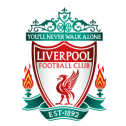
Is there anything actually wrong with Liverpool?
It’s been a baffling season for Jurgen Klopp’s squad. Their fundamental stats are mostly fine even if we concede they’ve been inferior to City. Their 2.0 expected goals per match ranks second in the league, and their xG differential (+0.7) ranks third. They start 10 possessions per match in the attacking third (first), they end 48% of their possessions there (second), and opponents only end in Liverpool’s defending third 29% of the time (second). All good things!
However, a combination of bad breaks, bad injuries luck and particularly bad errors has all but put an end to their title bid, however. For starters, the sometimes fatal flaw for possession teams has been devastating: while the Reds are second in the league in shots allowed per possession (0.09), they’re easily last in both shot quality categories: xG/shot (0.16) and xGOT/SOT (0.34). Granted, these issues became particularly problematic last week with keeper Alisson‘s series of ball-handling errors against Manchester City and Leicester City, but it’s been problematic all year, and for a couple of reasons.
1:27
Craig Burley explains how Liverpool got the better of Leipzig despite some risky play at the back.
First, congested schedules have created issues for plenty of elite possession-and-pressing teams; Bayern Munich, for instance, has even given up more high-quality opportunities this year. Second, injuries have laid waste to Klopp’s plans. Losing both starting central defenders, Virgil van Dijk and Joe Gomez, has resulted in Klopp dropping midfielders into defense, which in turn has hurt both the defense (guys are less familiar with their roles) and the offense (guys like Jordan Henderson aren’t involved in attack as much).
– Soccer’s clutch players: Messi, Lukaku, Morata score when it matters
– Marcotti: How “golden oldies” keep scoring goals across Europe
– Ogden: Seven reasons title race swung to Man City
Still, the Reds haven’t been nearly as bad as their results of late. They have averaged only 0.9 points per game over the past two months, and with a goal differential of minus-0.4 goals per match. But their xG differential in that span is +0.5 per match. Combined with a randomly strange goals distribution — they’ve scored three or more goals seven times in 24 league matches, but have also been shut out in five of their last nine — this has created randomly strange results.
As evidenced by their 2-0 Champions League win over RB Leipzig on Tuesday, Liverpool are still a tremendous team. The results will probably more closely reflect that soon enough, even if dreams of a repeat league title are almost certainly out the window.
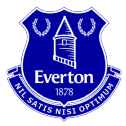
What exactly is Everton’s identity?
Carlo Ancelotti has enough raw talent at his disposal that when his Toffees look good, they look great. Dominic Calvert-Lewin has 13 league goals, veterans James Rodriguez and Gylfi Sigurdsson have combined for eight goals and 53 chances created, centre-backs Michael Keane and Yerry Mina are contributing on offense (five goals, five chances) while each winning over 60% of their duels.
Everton contained Leeds United in a 2-1 win on Feb. 3, sucked Manchester United into a 3-3 track meet at Old Trafford three days later and then beat Tottenham Hotspur, 5-4, in an FA Cup thriller, proving massive upside in each match. They sandwiched those matches with matching 2-0 losses to Newcastle United (17th place) and Fulham (18th place).
Everton have looked like a few different teams this year, and it’s produced a baffling statistical profile. On one hand, there are sturdy possession principles: they’re seventh in the league in passes per possession (5.3) and direct speed (Opta’s measure of the verticality of a team’s ball sequences). They offer solid possession length and width and a pretty slow tempo, and they don’t attempt many long passes. They try to control the ball, and they often succeed.
They also possess the ball only 47.7% of the time (14th), allow 0.14 shots per possession (13th), start only 6.4 possessions per match in the attacking third (14th) and allow 14.5 passes per defensive action (12th). Opponents average 5.7 passes per possession (14th), and 44% of those possessions end in the attacking third (19th!). This is a ball-control offense combined with a super-passive defense, and it’s producing a dramatic range of results.
Conflicting identities or not, Everton are on pace for 61.1 points after Wednesday’s 3-1 loss to Manchester City. That would typically earn you about a sixth-place Premier League finish. But the battle for fourth place is an absolute dogfight at the moment and could go to a team in the high-60s. It is, for now, still within reach at Goodison Park.
In other words, this would be a really, really good time for Everton to score its first derby win in a decade-plus. Especially if they don’t follow it up with another baffling loss.
1:20
ESPN FC’s Alejandro Moreno explains why Erling Haaland is the complete striker for Dortmund.
Revierderby: Borussia Dortmund at Schalke 044
Saturday, 12:30 p.m. ET (ESPN+)
Watch Schalke 04 vs. Borussia Dortmund, ESPN+ (U.S. only)
Last 10 derbies: five BVB wins, two Schalke wins, three draws
What’s at stake: Salvation. A pair of slumps has dropped BVB to sixth in the Bundesliga, six points back of a Champions League spot. Poor Schalke, meanwhile, needs to make up nine points on 16th-place Arminia Bielefeld to escape the automatic relegation zone. The loser of this one is going to find these respective tall tasks just about impossible.
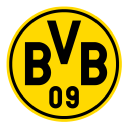
What’s behind the Dortmund malaise?
The Bundesliga’s version of Liverpool — Klopp’s influence, famously fanatical fans, “You’ll Never Walk Alone” — has been struggling through its own version of Liverpool’s season. BVB have been mostly fine on paper — third in the Bundesliga in xG and goals scored, third in xG allowed, second in possession rate, second in possessions ending in the attacking third, second in opponents’ possessions ending in the attacking third. Despite missing five matches, Erling Haaland is still on pace for 27 goals in league play, and Jadon Sancho and Rafael Guerreiro have combined for six goals and 93 chances created. They scored three goals on RB Leipzig in January, and on Wednesday in the Champions League, they scored three goals in 25 minutes against a stingy Sevilla.
Yet they’ve dropped copious points in creative ways. They’re averaging just 0.9 points per game in zero- to one-goal finishes, about half a point per game behind where a team of their overall quality would normally finish. That accounts for most of their shortfall in Champions League qualification at the moment.
They’ve dropped points for reasons that are and aren’t in their control. As with other possession teams, they give up high-quality chances to their opponents — they rank third in shots allowed per possession (0.10) but 11th in xG per shot allowed (0.13) and 13th in xGOT/SOT (0.33). They’re also failing to stop some potentially stoppable shots: injured keeper Roman Bürki and backup Marwin Hitz have combined for minus-1.8 goals prevented. BVB are allowing 1.29 xG per match, but it’s turning into 1.48 goals.
Worse yet, the timing of the goals they allow has been terribly inopportune. They’ve not only given up the first goal in 10 of 21 league matches — Dortmund have generated just eight points from these 10 matches and 25 from their other 11 — but half of those goals have also come in the first 15 minutes. This has undoubtedly been driven in part by sheer randomness and bad fortune, but it’s forced them to constantly chase games and attempt to salvage single points from previously winnable contests. Their goal differential is minus-0.2 over the first 60 minutes of matches and +0.7 over the final 30.
This poor timing is probably not something that continues, but it’s cost them dearly to date. And while their form, per xG differential, has been fine, they have to catch up to some smoking hot teams at the moment if they want to salvage a Champions League spot. Third-place Eintracht Frankfurt is unbeaten in its last 10 league matches, and fourth-place Wolfsburg is unbeaten in its last seven.
A loss to Schalke would be an utter disaster.

That’s not the first time “Schalke” and “disaster” have been used in the same sentence this year. The once-proud Königsblauen, second in the league as recently as 2018, have had more managers (four, including interims) than league wins (one) this season and came within a game of matching Tasmania Berlin’s seemingly untouchable, 31-match Bundesliga winless streak. Their form has undeniably improved since the start of the calendar year, but drawing five points from their last seven matches still isn’t exactly good.
In a last-ditch effort to save itself from relegation, the club loaded up on steely veterans in the January transfer window. They brought former Schalke star Sead Kolasinac back on loan from Arsenal and quickly made him captain. They brought in defender Shkodran Mustafi (Arsenal) and 37-year old striker Klaas-Jan Huntelaar (Ajax) on free transfers.
This was a “Save us!” starter kit, the player-acquisition equivalent of hiring Sam Allardyce to narrowly keep you up. And while they didn’t sign Big Sam, they did bring in veteran and former Spurs coach Christian Gross as Manager No. 4 in December. They’ve only gotten 190 minutes from Mustafi and Huntelaar, though, and quick math tells us how tall the task is here.
The 16th-place Bundesliga team has finished with an average of 32.5 points over the previous 10 seasons. Current No. 15 and 16 teams Hertha Berlin and Arminia Bielefeld are on pace for 29. It’s fair to assume, then, that after generating nine points from their first 21 matches, Schalke need 20-23 points over their final 13 matches to at least work their way into the relegation playoff (between the third-worst team in the top division and the third-best in the second division). That’s probably not going to happen, even if they pull off a stunner against BVB.
If you’re watching Schalke, then, you’re at least partially watching to see which young players they will be attempting to rebuild around in the 2. Bundesliga, and which they might be selling to top-division clubs on their way down…
– Attacking midfielder/left-winger Amine Harit, 23, leads the team with 33 chances created. He’s got one goal and five assists and is winning 53% of his duels this year.
– Midfielder Suat Serdar, 23, has 90 ball recoveries and eight chances created from a primarily defensive role. His stock has been dragged down by Schalke’s struggles, but a new environment might bring back his top form.
– American forward Matthew Hoppe, 19, was almost single-handedly responsible for Schalke’s lone win. He’s scored five times and created six chances in just 11 matches.
– Central defender Malick Thiaw, 19, has a goal and two chances and has won 53% of his duels in 10 matches.
One assumes that, having already sent defender Ozan Kabak to Liverpool, Schalke might have to sell Harit and Serdar once Schalke drop, and they might be able to get value out of a player like defender Salif Sane if he’s healthy. Either way, the youngsters are the most interesting thing about this soon-to-be second-division team, no matter how many veterans they’ve added of late.